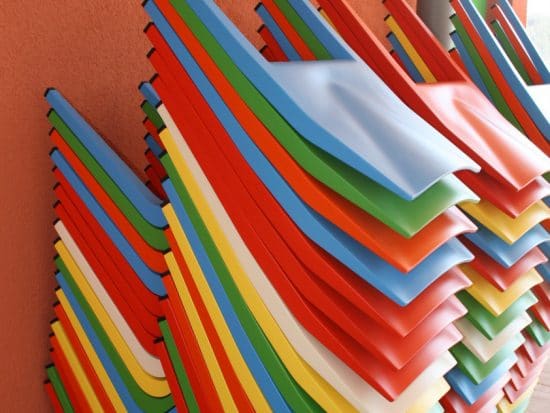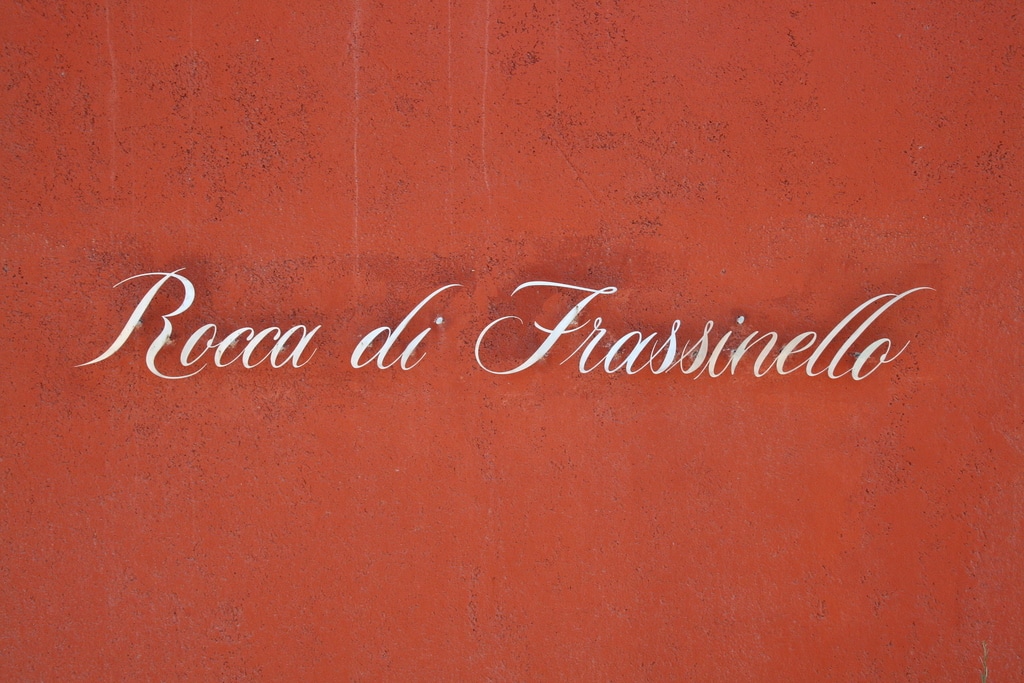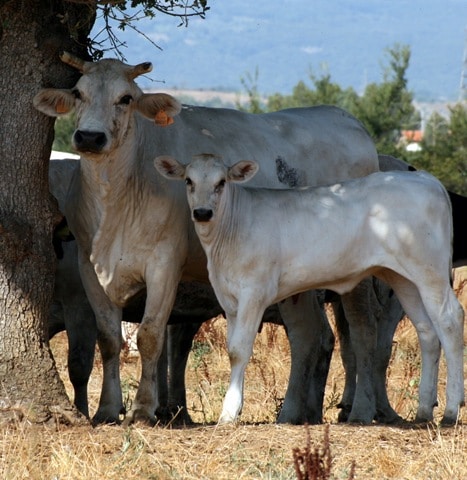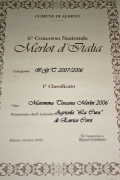La bella Massa Marittima
The quality wine area of Massa Marittima (DOC granted 1994) produces both traditional Tuscan styles and wines made from the fashionable French grape varieties. It will probably take decades to sort out what the area does best – or whether indeed it more a case of sub-zones with a particular vocation. But at the moment it is experimentation which rules – and the search for a really big name. Moris has been the biggest name, but there are now challenges from French and Italian investment. We will see.

The DOC was given the somewhat cumbersome name of Montereggio di Massa Marittima. Massa is the main town of the area while Montereggio refers to a now-destroyed castle at the top of the town. It could be thought that naming a DOC after modest castle ruins is asking for trouble … As we have spent many happy weeks in the town and its surroundings, the notes here are rather more detailed.
Links to featured wineries
- Moris Farms – quality and tradition
- Massa Vecchia – forward to the past
- Le Sedici – innovation and tradition
- Rocca di Frassinello – Chianti meets Rothschild in the Maremma
- Ampeleia – a concept wine
- Serraiola – experimentation in a family winery
- La Cura – a star Merlot
- Campo Bargello – a fine riserva
- Il Bacchino – Massa’s best enoteca
- and photogenic Massa Marittima
Updates
Scarlino and Gavorrano – sea, mines, vines
Following our summer visit of 2011, there is now a separate page on the wineries south of the modern Aurelia motorway on the road which runs from Gavorrano to the sea at Portiglione: for Scarlino and Gavorrano – sea, mines, vines, click here It is a very attractive area which combines the beautiful medieval hill towns of Scarlino and Gavorrano and the draw of the seaside. The featured wineries are:
2012’s summer visits were to the wineries on the road due south of Gavorrano and towards the outstandingly beautiful Castiglione della Pescaia which manages the perfect Tuscan combination of medieval hill town and seaside. In addition to the featured wineries this area is also home to the excellent Cacciagrande whose wines we have often enjoyed:
- Montebelli – luxurious rusticity
- Le Mortelle – Antinori’s latest cathedral of wine
- Tenute Perini – specialising in sweet wines
Moris Farms – quality and tradition

The unusual spelling (one ‘r’) apparently came from Spanish predecessors and the English name from a member of the family who had an eye to the American market. The leading wine family of Massa Marittima, Moris/Parentini, have both a wonderful site below the cathedral of Massa and a lovely old property at Cura Nuova (between Massa and the sea at Follonica) which serves as winery and HQ. They have vineyards both at Cura Nuova (37 hectares) and further south in the Morellino di Scansano DOCG (33 hectares). The wines are effectively promoted by the son, Giulio Parentini who is a stylish host and presenter. Overall the approach is a contemporary take on traditional Sangiovese, but with much power and more finesse than most. A good example of Vermentino is also made. 440, 000 bottles are made of which only 10% are white.
Vermentino was the first to be made from just this variety. At its best, it shows a marked mineral note, plus nuts and herbaceous quality. Mind you the 2005 was also good with mineral tones. The 2007 was fresh, with a fruity nose, excellent and refreshing (8/08), later showing floral and mineral notes on the nose, a good weight of fruit and some complexity (tasted 4/09 and 8/09). Its ageability is untested. The 2009 is subtle and quite powerful, more sophisticated than the very good newcomer we tasted in August 2010: Lillatraia, Vermentino 2009, Podere Casarecchia from Rossana Bennini which has a good depth of fruit ranging from melon to lime with good acidity and persistence.
Montereggio di Massa Marittima: tasting 2004 in 2007 I was struck by what excellent value this 90% Sangiovese, 10% Cabernet is and remains – very good red fruit, some perfume, very rounded in the mouth. The vines here are on clay and the wine benefits from time in barriques in the second year of use. Not one for long keeping but an excellent quality red. 2009 has a beautiful nose reflecting its time in barriques, though not quite so impressive on the palate. It remains impressive at 11 euros. Further south, two levels of Morellino are made on sandier soils:
Morellino di Scansano: this wine is matured in inert containers, ie no wood. The 2006 tasted in 2007 was still very purple, with great depth of fruit, rather dumb and needing more than the three months it had had in the bottle, the 2005 was purply-red, very fruity, extremely drinkable. The 2007 was declared to be the best vintage for 25 years, a proper celebration of the awarding of the more prestigious DOCG quality category – vibrant red, fantastically fruity, very good (8/08). The 2008 also has excellent fruit, cherries, plums and plum stones (90% Sangiovese, the rest Merlot and Syrah). The 2009 is very fruity, dense and delightful.
Morellino di Scansano Riserva: same grape blend as above but aged in barriques (second year again): 2004 tasted 6/07, great sweet nose of fruit and spiciness, concentration, lots of acidity and silky tannins, a big step up in seriousness, perhaps with 10-15 of ageing potential; 2005 is a good deep colour, cherry and plum, very rich in the mouth, a good result in a mixed year. 2009 is very dense, far more sophisticated and complex than the normale.
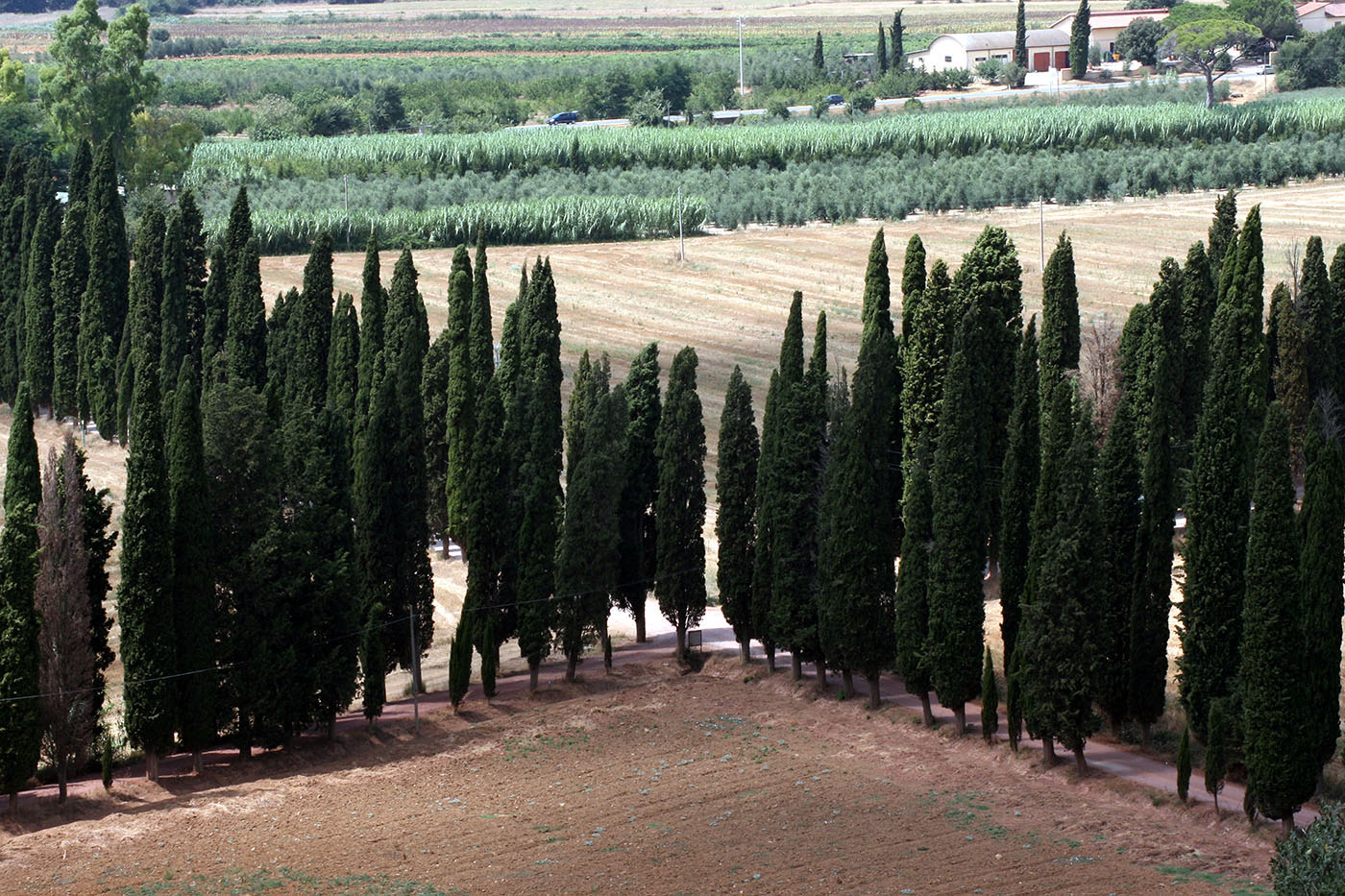
Attentive readers will have been wondering what Moris do with their new oak barriques and the answer is to reserve them for Avvoltore, the top wine of the Cura Nuova estate. A single-vineyard wine, Avvoltore is the local name for an eagle. The grape mix is 75% Sangiovese, 20% Cabernet and 5% Syrah, so a Super Tuscan in weight and style. Yields are also low, some 40% less per hectare than the Montereggio. The wine is then matured in mainly (80%) new oak barriques for a year and in bottle for 6 months before release. Poorer years are declassified, eg 2005, which meant that the Monterregio was particularly good that year – every cloud has a silver lining! The wine has to be classified ‘only’ as IGT Maremma as the DOC would require at least 80% Sangiovese and not more than 10% each of other grapes, but this is no real loss – apart from to the DOC itself – as Montereggio di Massa Marittima sounds obscure whether you are in Milan or New York. For a new quality wine zone, this was an own goal – in the Maremma more generally, only Bolgheri created a DOC with some real flexibility in it.
In Avvoltore, Moris are looking for a combination of drinkability, power and elegance and pretty much succeed. The excellent 2004 received 93 points from the blessed Parker.
2004: a deep prune and grape nose, rich in the mouth, with huge rounded dark fruits, spices, some herbaceousness, liquorice; very long (tasted 6/07 and 8/07). Richard Baudains in Decanter (August 2008) gave it the maximum 5 stars for the first time: ‘Concentration of colour, rich nose of plum pudding and herbs. Huge, velvety mouthful. Extrovert wine with quintessential Maremma character. [Drink] 2009-2020.’
2006: the wine had a lovely deep core, dense and rich (a rather abbreviated note in the scrum at Vinitaly, 4/09); complex silky nose, beautiful oak and fruit; dense fruit which still needs time in the bottle despite its drinkability, 8/09. In August 2010 it was showing a beautifully complex and sophisticated nose, subtle and velvety, typical sour cherry and plum fruit overlaid with oak and balsam, excellent acidity and fine tannins, very long, still very young indeed. Very classy.
2007: has been released, rather too early according to some (there was no 2005 or 2008), but should be beginning drinking well now.
Massa Vecchia – forward to the past
It can only be 10 kilometres from the foot of the Massa hill to Moris Farms – we did walk once across the fields from Massa to Valpiana in temperatures in the mid-30s and remembered why we talk about mad dogs and Englishmen. But the worlds of Moris Farms and Massa Vecchia could not be further apart. Massa Vecchia, ‘old Massa’, is named after the locality and has been driven on a very individual pathway for the last 25 years by Fabrizio Niccolaini, now assisted by his daughter Francesca. Fabrizio is a paid-up member of Vini Veri (true wines) and has pursued ultra-low intervention and traditional methods: seeking out old varieties of local grapes to grow, ploughing with oxen, absolute minimum use of sulphur dioxide – there is is even talk of a return to mixed cultivation, the old system of a whole range of crops in one field. He started with the Tuscan basics of Sangiovese and Trebbiano back in 1984 and has since added Aleatico, Alicante (in the Maremma since 1800), Vermentino, Ansonica, Malvasia Nera, Malvasia di Candia – a pretty good introduction to Tuscan varieties. He then, slightly surprisingly added Cabernet and Merlot. The winemaking is very old style with long maceration of the musts, including 3-4 weeks for the whites … The keyword is integro – nothing added, nothing taken away. Not surprisingly, the wines taste very different to the near-ubiquitous modern, clean, fruit-led style. For a fuller write up of this special winery, see my piece in special places. Massa Vecchia also contributes to the online Tuscan harvest diary on this website.Wines tasted 31 July 2009:
Ariento 2007: the ‘white’ used to be blend but now is two different wines, this one being 100% Vermentino, but utterly different from everyone else’s. In the glass, there is an orange tinge to the mid-yellow colour, partly due to ageing in small old barrels. In the mouth, there is a dense texture, orange skins, more of a food than a drink.
Bianco 2007: Malvasia di Candia from old vines (60-70 years), again a complex mix of wild herbs, some oxidisation, great extract. Seemed an impossible wine to match with food, though its maker plumped for raw seafood.
Cabernet Sauvignon 2006: a quite unrecognisable nose of plum stones and minerals, on the palate quite tough, dense and rustic. Not sure where this is heading!
Aleatico: more conventional, roses and plums on the nose, sweet but with good acidity, similar density to the above but more approachable
We bought, but haven’t yet tasted the Sangiovese, and there is also a Rosé.
2012 update
We visited Francesca again in August 2012 when she seemed confident and entirely in charge of the winery, having now had a couple of years of experience as the person at the helm. During our stay, we enjoyed both of the new Merlot wines (one called In bocca al lupo and the other, of course, Crepi) with fruit farmed by them on others’ vineyards and made in another local winery but by Massa Vecchia – it is a tiny farm with no space for expansion. We tasted the mainstream wines in the barrels:
Bianco, IGT Toscana 2010 – 40% each of Trebbiano and Vermentino, 20% Malvasia Bianco di Candia, a fine nose of orange peel, high perfumed nose, tangerine and apricot on the palate, good; fair persistence. Will be available in October.
Rosato IGT Toscana 2010 – a blend of Merlot and Malvasia Nera, both of which give off colour quickly so for even a medium depth pink wine this needs only eight hours on the skins. Red fruit, perfume, peach and a distinctive salt finish; mature fruit again very evident.
Berace IGT Toscana 2010 – 60% Sangiovese, and then Merlot/Cabernet Sauvignon from the vineyards inland at higher altitude which Stefano and Francesca have as a mixed farm. Technically it is ‘bought in’ fruit which can be commercialised as Massa Vecchia; in reality, it is their own vineyard which they rent and farm. The Sangiovese here is harvested late in October because of the altitude – a good balance to the warmer La Querciola vineyard at Massa. This wine is made without the addition of any sulphur dioxide. Deep cherry and plum fruit, moderately aromatic, but great fruit which will develop in the bottle.
La Querciola IGT Toscana 2009 – this is the single vineyard 100% Sangiovese wine. If all the others were not so good and so unusual, this would be regarded as their top wine. From a more typical year than the summer of 2012 which we were experiencing, so some heat but not unrelenting. Very good fruit that almost tastes sweet because of its full ripeness, structured but with balancing acidity and fine tannins, exceptional – the best they have made they believe and I can see entirely why.
Aleatico 2009 – rich full-bodied, perfumed, delicious. Aleatico is a small grape which dries (here on the plant) for a few days before it is picked and processed. Just 10% alcohol – good for breakfast!
And the prospects for the hot 2012? The Vermentino and Aleatico are virtually ready (7th August) and will be very good. The Sangiovese at altitude will be very good, with some question marks about the Massa vineyards because of the persistent drought and high temperatures. But Massa Vecchia believes in letting the season express itself and in making wines with the available grapes – so the wines do change from year to year.
Updated August 2012
Le Sedici – innovation and tradition again
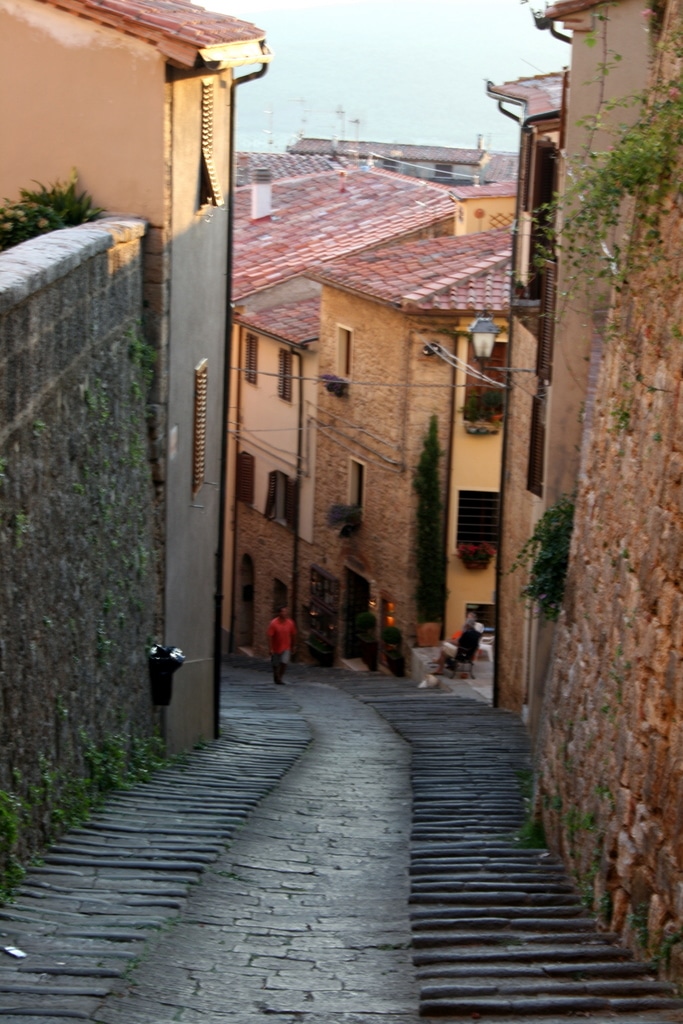
Literally next door – or should that be next field – to Massa Vecchia are the Sedici vineyards. They also have a shop in Massa itself where you can taste the wine, very conveniently, without leaving the town. It used to be on the picturesque Via Moncini, left) but it now has the best spot in town, on the main piazza right opposite the cathedral. Marisa Menichetti has revived the old coinage of medieval Massa for the label and produced a good range of wines, in small quantities, mainly based on Sangiovese. Except for the ‘Rosso’ which is Montereggio di Massa Marittima DOC, all are IGT Maremma Toscana. Wine tasted in August 2008 and 2010.
Rosso 2007: Mostly Sangiovese, 10% Cabernet, macerated for around 4 days: dark berries, smoky, oak evident, pleasant acidity, lovely bitter finish (Aug 08)
Rosa del Guerco, Rosato 2007: 100% Sangiovese in this rosato, kept on its lees for 4 months for a bit more complexity: average nose, nice structure, sweet fruit. Thank you to the Swedish/British couple who shared this wine with us after their heroic cycle from Pisa in the heat of the Tuscan summer. (Aug 08)
Il Guerco 2007: The name ‘the miner’ picks up the dependence of the area on mining in previous centuries. Sangiovese and Cannaiolo, no maturing in wood as the wine has been made to drink with fish. Good fresh fruit, pleasant. We then recommended this to the new, refined, fish restaurant in Suvereto, Ristorante dal Cacini! (Aug 08) 2009: simpler than the top wine, rather unfocused on the nose, fair.
Grosso Massano Selezione 2006: This is named after the silver coinage minted in the town in 1317. 100% Sangiovese from best areas, matured in a mixture of inert containers and new barriques; subtle and dense nose, the sweetness of ripe fruit, strong balsamic notes. 2007: very good Sangiovese showing clear signs of having been in barriques, smoky, leather, cherry, good texture, long. There is also an unoaked version of Grosso Massano, slightly confusingly, non selezionato I suppose.
Rocca di Frassinello – Chianti meets Rothschild in the Maremma
We briefly leave the world of the family farm to engage with the wine aristocracy. In the 1990s there was a ‘wine rush’ in the Maremma as the best sites in Bolgheri had been snatched up and investors were looking for the next big thing. The Rocca di Frassinello was a bit of a latecomer, being built in 2002-7, in the southernmost part of the area. It has at least some Tuscan blood in it as it is a joint venture between Castellare di Castellina (Chianti) and Domaine Baron Rothschild-Lafite. The estate is large, 500 hectares altogether of which 80 are under vine, no doubt with the possibility of expansion if all goes well. If you are going to make your mark, you can, of course, do what others did before (see Petra in the Val di Cornia section) and go in for a grand architectural statement. None come more famous in Italy than Renzo Piano who designed this minimalist super-chic winery. Stunning it is too, if in a slightly austere sort of way, offset by the occasional splash of colour, but there is no gainsaying its interior splendour.

Three wines are produced, all red. All are Super Tuscan blends, trading as IGT Maremma Toscana, though needless to say this is not going to be the selling point. They will have to sell themselves on their inherent quality, helped by a big Chianti name and an even bigger French chateau name.
Poggio alla Guardia 2006: the baby super-Tuscan blend of 15% Sangiovese, 45% Merlot and 50% Cabernet, no wood ageing, spicy, remarkably deep colour and flavour for an unoaked wine, good acidity. 2006 was an exceptional year but this area is genuinely hot, around 5° hotter than Chianti and so retaining acidity is a key goal.
Le Sughere di Frassinello 2004: a slightly more Tuscan influenced blend of 50% Sangiovese and 25% each Merlot and Cabernet Sauvignon. Having said that, that’s still 50% French beef which will overpower most Sangiovese. This spends 15 months in barriques, 50% of them new and 50% older from a certain Ch. Lafite. A lovely, rounded nose, denser, good use of wood, ie not overpowering the red and black fruit. Pretty sophisticated at a reasonable price (€18).
Rocca di Frassinello 2004: the top wine does put Sangiovese to the fore at 60%, with 20% each of our French friends. It’s aged in new barriques, so no borrowed glory from Ch. Lafite in these bottles. Complex nose with notes of cherries/plums, blackberries, raisins, plus some balsamic notes, great persistence, scope for bottle ageing. Big jump in price to €38 – but that’s cheap compared to the denizens of Bolgheri which will be its competitors. This top wine got the coveted ‘three glasses’ from Gambero Rosso for the 2006 vintage as it had done in 2005.
Re-tasting these three in the fun, but less than ideal circumstances of the Calice di Stelle (night-time wine festival on the streets of Massa on the night of San Lorenzo, 10 August 2009), what really struck me about these wines is their sophistication and poise. There are lots of excellent fruit-led reds in the Maremma and there is great everyday drinking, but there are not too many sophisticated glasses. We should hear a lot more about this particular Rocca in the future. But others may disagree: some of the 2007s are criticised for lack of drinkability and over-extraction by L’espresso 2010.
At the Rocca , even the animals are beautiful!
Ampeleia – a concept wine
If the Rocca di Frassinello is in the south of the zone, Ampeleia is deep inland near Roccastrada. In fact if you come at it from the Siena road you drive through forest to reach it. Needless to say, the winery and vineyards are in the first bit of cleared land in a pretty spectacular setting. The very best place to see the whole view is from a balcony table at the excellent local restaurant across the valley, as in the picture: well someone had to do the research! Ampeleia succeeded the Fattoria di Meleta on this site, but now has vineyards at three levels between 200 and 600m above sea level, giving it a good range of terroir.
This winery is unusual in that the three friends who founded it first decided the style of the wine they wanted and then sought out the place, the grape varieties and all the practical details, the exact opposite of the usual way of working. Given they wanted an approachable, elegant Mediterranean style, it is rather surprising that they have ended up relatively far inland, but it seems to work. The first wine was produced in 2002, again testimony to continuing inward investment at the turn of the century. The choice of grape varieties also shows a certain independence of mind: Grenache, Marselan (a cross between Grenache and Cabernet Sauvignon from the Languedoc), Mourvèdre, Alicante, Carignan, Cabernet Franc and a small amount of Sangiovese. I am not sure the Cab Franc, a large component of the top wine, counts as Mediterranean, but I did say it was a concept-driven wine, so perhaps we should not be too literal (littoral?)
Ampeleia: 50% Cabernet Franc plus the six other grapes above. This is the top wine, matured in barriques (40% new) for two years, then more time in the bottle, with a view to a wine which can age for 15-20 years. 2004: tasted 7/07: big dark chocolately nose, spicy, excellent dense fruit, rather sharp and tannic still (would be fine with food), real potential. 2006: good complexity on the nose, tobacco and leather, multi-layered fruit, sophisticated and full.
Kepos: a new wine made of the five minor grape varieties in Ampeleia, matured in large barrels and in inert containers. Nice complex fruit-driven nose, fragrant, cherry notes, quite a sweet finish (no Sangiovese!) The 2006 got the vineyard’s first ‘three glasses’ award from the Gambero Rosso, not a mean feat for the second wine.
There is a good account of the project in the Italian wine magazine, Il mio vino, July 2007, 99-102
Serraiola – experimentation in a family winery
In the plethora of experimentation which is going on in the Massa Marittima DOC, Serraiola stands out for its attempts to forge new styles on the basis of a medium-sized family farm (40 hectares of which 12 are vines) and at reasonable prices. The Lenzi family have been here for 40 years and it is genuinely touching to walk around the vineyards with the father of the family as he points out the vineyards that he himself planted 40 years ago and which are now mature. On another visit, he is to be found in the heat of the summer helping the labourers tend the newly planted Marsanne and Roussane grapes – white Rhône rangers – which the latest experiment. In the intervening years, they have planted Merlot, Syrah and Vermentino.
Fiorella Lenzi now also gives time to promoting the strada del vino (‘wine road’), the key organisation which promotes wine and food tourism in the area. (Like most of these initiatives, it produces a very useful map of the area with wineries and other services and a website.) If you look carefully in the barricaia which doubles as a reception area at the winery, you will see the flag that indicates that she is a viola, ie a supporter of Fiorentina football team. They also produce excellent prosciutto.
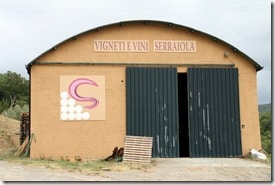 |
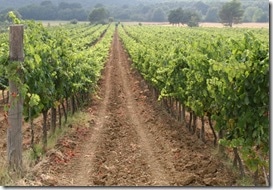 |
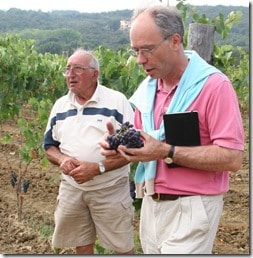 |
 |
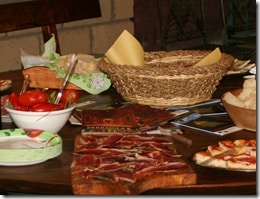 |
 |
I first came across Serraiola’s wines at the Massa wine festival in August 2006 when I noticed the range and interest of the wines. A visit to the winery in May 2007 bore this out and I have been back several times since then. There are top wines here but also a great range of everyday ones. In terms of wine styles, it is very close to the Val di Cornia with a similar emphasis on non-Tuscan grapes. Fiorella does make two Sangiovese wines but then says dismissively that it’s not a noble grape (!) Well, her two top wines are made of Merlot and Syrah so perhaps she would say that. In 2010 I learned that her enologist, Fabrizio Moltard, seems to excel in Super Tuscan wines.
Vermentino (100%) is increasingly important to Serraiola but I prefer their blend, Violina (Chardonnay, Sauvignon, Trebbiano), a good colour, lively floral and fruity notes, a good quality white, named after a favourite beach ( = perfect combination). The rosato, Fioreviola, has nice light Sangiovese character, and probably what you need after a hot day travelling to Florence to support the football team. As a Sangiovese fan, I can never quite make my mind up about the two red versions here: Cervone is unoaked, nice fresh fruit, slightly herbaceous, good rasp of acid and tannin; and Lentisco, oaked, rather more serious but still around the €10 mark, rounded fruity bouquet, some figginess and prunes, not that intense. ‘Sound and enjoyable’ said Gambero Rosso 2009 of the 2007 and 2006 respectively. But it is the Super Tuscans which have caught the eye: Shiraz: we are not in Australia but the name picks up the hot climate here in the Maremma and tells you what to expect, burnt rubber and oak, some caramel, good fruit, persistent. The 2006 got to the finals of the Gambero Rosso in 2009, as did Campo Montecristo in previous years. The last wine was mostly Merlot with some Sangiovese and syrah and has now become 100% Merlot, with low yields of 800g per plant. Twelve months’ repose in barriques and time in the bottle completes the wine. The name celebrates one of the most exotic and unreachable islands of the Tuscan archipelago. It’s a big glass of wine, with dense fruit, silky (2006), typical mixed dried fruit smells of Merlot (Christmas cake), needs some time (tasting 2007 in April 2009). I look forward to tasting the new Rhône-inspired white in due course and will keep one eye on Fiorentina’s fortunes in the Champions League (due to play Bayern Munich in their first-ever appearance in the knock out rounds, having won their qualifying group). They were knocked out through poor luck with the referee in Germany and the exceptional talent of Arjen Robben.
La Cura – a star Merlot
The village of Cura Nuova is on the main road between the hill town of Massa Marittima and the sea at Follonica. Everything passes through it at the moment but in the five years we have been visiting a new road has made snail-like progress. It may yet either connect it more quickly to the towns or leave it in peace. There is a bar and a fruit shop and that is about it. The fruit shop, it turns out, belongs to the La Cura estate, founded in 1968, now expanded to 15 hectares under vine and in the capable hands of Enrico Corsi.
The range of wines here is impressive – in the quality wines, two whites, three reds and a so-far unique sweet wine. All wines tasted in August 2010:
Valdemar Vermentino 2008: this white has the family name ‘Valdemar’ and is marked by a good floral nose and a nice herby palate. No oak.
Trinus 2009: an equal three-way split between Chardonnay, Vermentino and Malvasia. The fact that it is partially fermented and aged in oak, some of it new, signals and indeed delivers a more structured wine. It is a good blend – Chardonnay on its own here tends toward the over-exotic, but in this example, it is cut by the Vermentino and perfumed Malvasia. Initially subtle on the nose but opened up enormously in the glass.
Colle Bruno 2008: for the purposes of the DOC this is 85% Sangiovese, here beefed up with a considerable 15% of Cabernet Sauvignon. 50% of the new wine is aged for eight months in barriques. Great depth of fruit, good. Discussion ensued about the relative merits of reconstituted cork for the cheaper wines (they are actually better than the traditional corks but customers won’t believe that).
Brecce Rosse 2008: named after the red soils of the area, this is 80% Sangiovese plus Cabernet and Merlot, and gets the longer 10 months in barriques treatment. A much finer nose of red fruit, good structure, very refreshing despite its 15 degrees of alcohol.
Merlot 2007: the star wine of the concern, the 2006 winning the ‘Merlot d’Italia’ competition for its category. 100% Merlot, aged for 12-18 months in the larger 800-litre casks, intended for fruit-driven wines. Evolving nose of red fruit, spices and dried fruit (real Christmas cake nose!), fabulous palate, spicy, fruit, leather, tobacco. Very good indeed.
Predicatore 2008: A genuine novelty and a great bit of domestic economy to boot. The standard practice for quality nowadays is to carry out what is called euphemistically a ‘green harvest’. In reality what happens is that any excess fruit is cut off from the vines as they mature, allowing the plant to put all its resources into the remaining grapes – and wasting the bunches cut off which just lie on the ground and rot. It seems all wrong. But here the discarded grapes are dried out in the sun, vinified in new wood barriques and are turned into a substantial dessert wine or ‘meditation wine’ as the Italians like to say. According to Enrico, the key is that this is 90% Merlot and a bit of Aleatico, and therefore less tannic than the traditional sweet Aleatico of the region. Whatever the explanation, this is rich, sweet, moderately acidic, full of dark fruit and very drinkable. It is named after San Bernardino, the famous preacher who was borne in nearby Massa Marittima before going on to fame in Siena. We wait to see if the same happens to this extraordinary wine! The circle was completed by us visiting La Cura with friends who are both the children of preachers … ‘the stone that the builders rejected has become the cornerstone’
Campo Bargello – a fine riserva
We have not visited Campo Bargello yet, south of Massa Marittima, but it produces some good wines. For example, Campo Bargello riserva 2005, accompanied us on an opera evening at the Osteria Grissini. This is situated right on the edge of the piazza so you can have your meal, move into the piazza for the opera and come back and enjoy the rest of your bottle during the interval. The riserva is 80% Sangiovese, 20% Cabernet (possibly with some Alicante), tasted 8/08, dark ruby red with purple edges (still after three years), rather dumb on the nose to start with, but two hours later, much opened up, Cabernet blackcurrant bouquet aroma more evident, layers of flavour now. The wine obviously enjoyed the Verdi too. Very good.
Bella Massa Marittima
Massa Marittima is so photogenic so I will finish this section with a few shots which give a tiny glimpse: the cathedral, the wine festival at night, the fruit stalls, music of various styles, the medieval walls and the Chapel of St Bernardino.




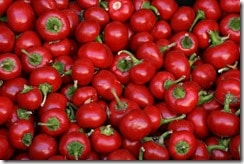

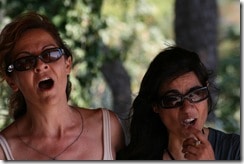

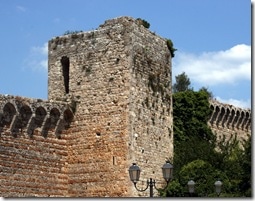
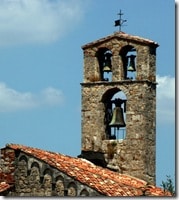
Next: Bolgheri – the starting point of the Super Tuscan wine rush


